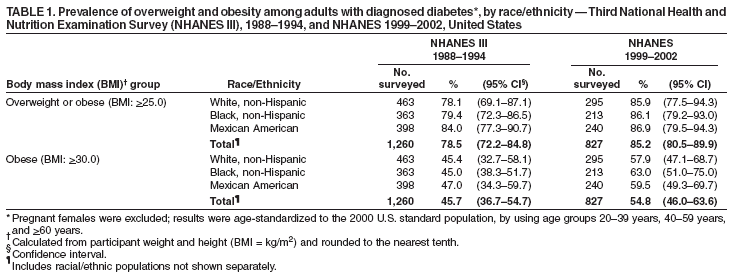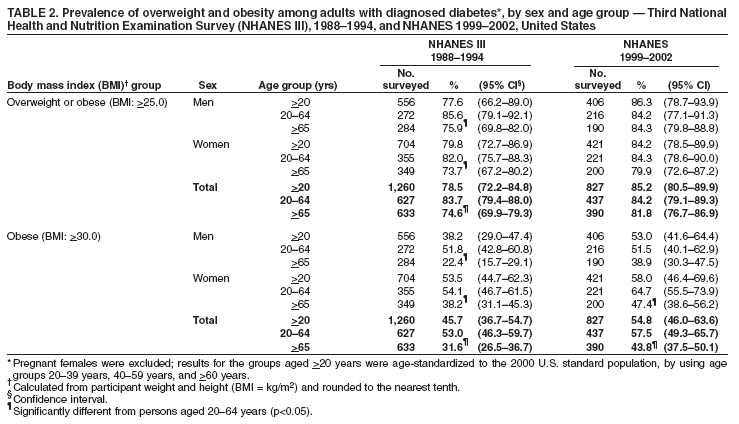 |
|
|
|
|
|
|
| ||||||||||
|
|
|
|
|
|
|
||||
| ||||||||||
|
|
|
|
|
Persons using assistive technology might not be able to fully access information in this file. For assistance, please send e-mail to: mmwrq@cdc.gov. Type 508 Accommodation and the title of the report in the subject line of e-mail. Prevalence of Overweight and Obesity Among Adults with Diagnosed Diabetes --- United States, 1988--1994 and 1999--2002Obesity in persons with diabetes is associated with poorer control of blood glucose levels, blood pressure, and cholesterol (1), placing persons with diabetes at higher risk for both cardiovascular and microvascular disease (2). Conversely, intentional weight loss is associated with reduced mortality among overweight persons with diabetes (3). CDC analyzed the prevalence of overweight and obesity among U.S. adults aged >20 years with previously diagnosed diabetes by using data from two surveys: the Third National Health and Nutrition Examination Survey (NHANES III), 1988--1994, and NHANES 1999--2002. This report summarizes the results of that analysis, which indicated that most adults with diagnosed diabetes were overweight or obese. During 1999--2002, the prevalence of overweight or obesity was 85.2%, and the prevalence of obesity was 54.8%. Encouraging patients to achieve and maintain a healthy weight should be a priority for all diabetes-care programs. NHANES is a continuous survey of the health and nutritional status of the U.S. civilian, noninstitutionalized population; samples are selected through a complex, multistage probability design. Diabetes status was determined in household interviews with participants aged >20 years. In NHANES III, 1988--1994, participants were asked, "Have you ever been told by a doctor that you have diabetes or sugar diabetes?" For women, the question was preceded by "other than during pregnancy." In NHANES 1999--2002, the same questions were asked, but "doctor" was replaced with "doctor or health-care professional." Participants who responded "yes" were categorized as having diagnosed diabetes. The body mass index (BMI) of each participant was calculated as weight in kilograms divided by height in meters squared. Overweight was defined as a BMI of 25.0--29.9 and obesity as a BMI of >30.0 (4,5). Pregnant women were excluded from the analysis. Data were analyzed with sample weights to account for differential probabilities in the sample selection, nonresponses, and sample noncoverage. Two sample t-tests were used to test differences in proportions and determine the statistical significance (p<0.05) of differences in results by age, racial/ethnic population, and survey period. Percentages of racial/ethnic populations and persons aged >20 years were age-standardized to the 2000 U.S. standard population. Among all survey participants with diagnosed diabetes, the prevalence of obesity was similar for the periods 1988--1994 (45.7%) and 1999--2002 (54.8%) (Table 1). In the 1999--2002 survey, the prevalence of obesity among adults with diagnosed diabetes was 57.9% for non-Hispanic whites, 63.0% for non-Hispanic blacks, and 59.5% for Mexican Americans. Similar prevalences of overweight and obesity were observed in these racial/ethnic populations during 1988--1994. Among men in the 1999--2002 survey, the prevalence of overweight or obesity was 86.3%, and the prevalence of obesity was 53.0% (Table 2). Both the prevalence of overweight or obesity and the prevalence of obesity were similar among men aged 20--64 years and >65 years. Among women in the 1999--2002 survey, the prevalence of overweight or obesity was 84.2%, and the prevalence of obesity was 58.0%. Compared with women aged >65 years, women aged 20--64 years had a significantly higher prevalence of obesity (64.7% versus 47.4%) (p<0.05). Reported by: MS Eberhardt, PhD, C Ogden, PhD, National Center for Health Statistics; M Engelgau, MD, B Cadwell PhD, Div of Diabetes Translation, National Center for Chronic Disease Prevention and Health Promotion; AA Hedley, PhD, SH Saydah, PhD, EIS officers, CDC. Editorial Note:The prevalence of obesity among adults overall in the United States increased from 22.9% during 1988--1994 to 30.5% during 1999--2002 (5,6); the prevalence of obesity among adults with diagnosed diabetes remained high, at 45.7% during 1988--1994 and 54.8% during 1999--2002. Weight management, through healthy eating and physical activity, can help reduce the number of persons at risk for diabetes and reduce the risk for complications and premature mortality among those who already have diabetes. The findings in this report are subject to at least three limitations. First, the NHANES surveys exclude institutionalized persons, including those in nursing homes, a population with a high rate of diabetes (7). Second, the number of persons with diagnosed diabetes surveyed limited the power of the analysis and precluded stratifying the results by multiple demographic groups. Finally, greater clinical vigilance of overweight or obese persons might have resulted in a greater proportion receiving diagnoses of diabetes. The National Diabetes Education Program (NDEP), cosponsored by CDC and the National Institutes of Health (NIH), has an ongoing community campaign to reduce morbidity and mortality, Control Your Diabetes for Life, which educates persons about healthy eating and weight control. Information about the campaign is available from NDEP at http://www.ndep.nih.gov/campaigns/controlforlife/controlforlife_index.htm. Research into the effects of obesity on diabetes includes a multicenter clinical trial, sponsored by NIH and CDC, to determine the long-term health benefits of an intensive lifestyle intervention designed to achieve and maintain weight loss (8). The health consequences of diabetes are compounded by overweight and obesity. However, the prevalence of overweight and obesity among persons with diabetes has not been monitored regularly. Findings in this report provide baseline data to track future trends that will enable public health agencies to assess the scope of this public health concern, target programs, and allocate resources accordingly. References
Table 1  Return to top. Table 2  Return to top.
Disclaimer All MMWR HTML versions of articles are electronic conversions from ASCII text into HTML. This conversion may have resulted in character translation or format errors in the HTML version. Users should not rely on this HTML document, but are referred to the electronic PDF version and/or the original MMWR paper copy for the official text, figures, and tables. An original paper copy of this issue can be obtained from the Superintendent of Documents, U.S. Government Printing Office (GPO), Washington, DC 20402-9371; telephone: (202) 512-1800. Contact GPO for current prices. **Questions or messages regarding errors in formatting should be addressed to mmwrq@cdc.gov.Page converted: 11/18/2004 |
|||||||||
This page last reviewed 11/18/2004
|